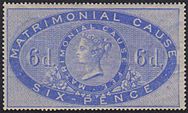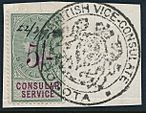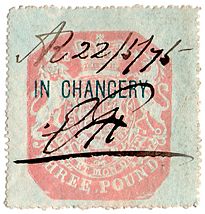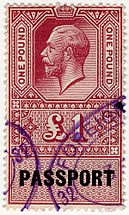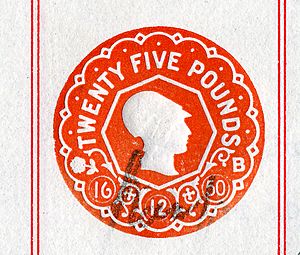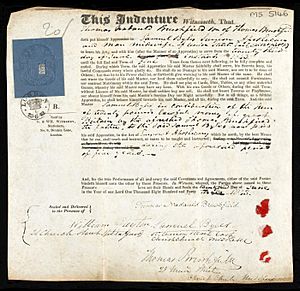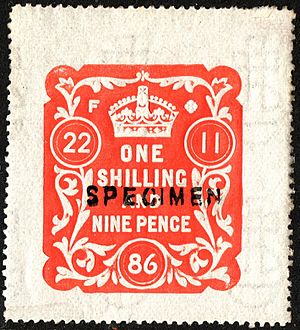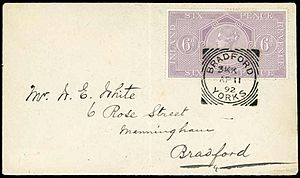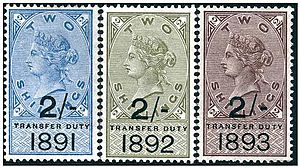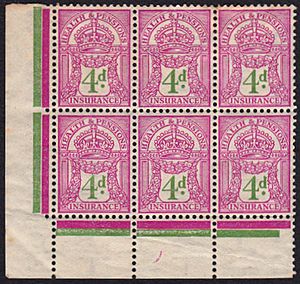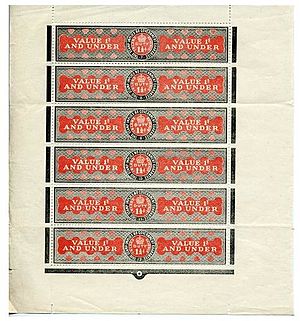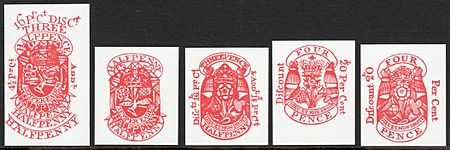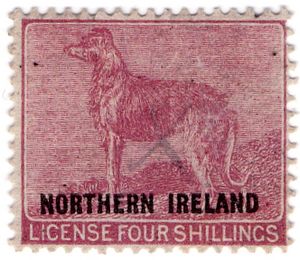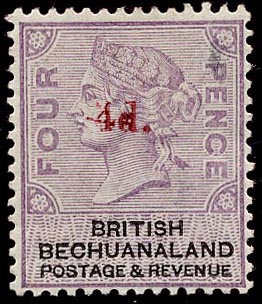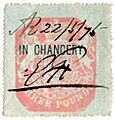Revenue stamps of the United Kingdom facts for kids
Revenue stamps are special stamps used in the United Kingdom to show that taxes or fees have been paid. They are also called fiscal stamps. These stamps can be sticky labels, like postage stamps, or designs pressed directly onto paper. The UK has used these stamps since the late 1600s, and some forms are still used today.
The very first stamps for taxes were pressed onto paper in 1694. These "impressed duty stamps" helped collect many different taxes for centuries. They are even still in use in some ways today.
The first sticky revenue stamps were for chocolate tax in the 1740s, but none of those exist anymore. The oldest sticky stamps we still have were used in the 1780s for taxes on hats, gloves, and perfume. This means revenue stamps were around before the famous Penny Black postage stamp, which came out in 1840.
In the mid-1800s, sticky revenue stamps started to look more like postage stamps. Many different types were used, including those with pictures of the king or queen. Most stamps were put on documents, but some, like medicine duty stamps, were stuck right onto the product being taxed.
Fewer revenue stamps were used after the 1960s. However, some types, like those for television licences, were still issued until the late 1990s. Today, only impressed duty stamps and special labels for alcohol tax are still in use. Besides national stamps, some parts of the UK, like Northern Ireland and Scotland, also had their own revenue stamps. Even some local areas issued stamps. The UK's use of these stamps also influenced how its colonies used them.
Contents
What are Impressed Duty Stamps?
The first revenue stamps in the UK were impressed duty stamps. These were introduced in 1694 to collect a new tax called Stamp Duty. This tax was meant to help pay for a war against France. It put a tax on many legal papers, like insurance policies and court documents. The tax could be as little as one penny or as much as several shillings.
This tax raised about £50,000 a year, which was a lot of money back then. Even though it was supposed to be temporary, it worked so well that it stayed. New taxes have been added over time, and impressed duty stamps are still used to collect some taxes. However, electronic ways of paying taxes are now becoming more common. Since the 1600s, about 10,000 different designs of impressed duty stamps have been used. Some of these stamps had values up to £1 million!
To make sure people paid the tax, documents were not valid in court if they didn't have the right stamp. The tax was either a set amount for each document or a percentage of the value of the deal. The Board of Commissioners of Stamps was in charge of issuing these stamps. People called distributors were chosen across the country to hand out the stamps. For example, the famous poet William Wordsworth was a stamp distributor in Westmorland.
At first, the stamps were designs pressed into the paper without any color. This is called embossing. In the 1850s, colored ink was added to the embossed designs. It was first pink, then changed to red in the 1870s. Blue ink was used for duplicate stamps.
For thick materials like vellum (a type of parchment), which couldn't be embossed directly, a piece of paper was glued to the document with a thin strip of tin. The stamp was then embossed onto this paper. Different colored papers were used, including red, green, and blue. The tin strip on the back was covered with a small paper seal that had the king or queen's symbol. These seals were used from 1701 until 1921.
Most embossed stamps were for general use, meaning they could be used for many different taxes. But sometimes, special stamps were made for specific taxes or fees, like those for "Bill or Note" or "Royal Courts of Justice."
Sticky Revenue Stamps
Embossed Sticky Stamps
By the mid-1800s, using impressed stamps was very common. To make it easier, stamps started to be embossed onto sheets of sticky paper. These could then be cut out and stuck onto documents. The first sticky general-duty revenue stamps came out in 1855. At first, they were not perforated (no little holes to tear them apart easily). But from 1870, they started to be perforated.
These stamps were first pink, then changed to red in 1875, and blue around 1887. General-duty sticky revenue stamps were used until the early 1900s. Sometimes, special dies (tools for pressing designs) were used to cancel these stamps, similar to how postage stamps are cancelled.
Besides general-duty stamps, some embossed sticky stamps were made for specific taxes. Sometimes the paper already had words printed on it, like "Customs" or "Land Registry," before the embossing was added. There were also unique embossed stamps with specific names like "Chancery Fee Fund" or "Consular Service."
Receipt, Draft, and Inland Revenue Stamps
In 1853, two 1d (one penny) revenue stamps were issued. They showed Queen Victoria and said "Receipt" or "Draft." These stamps were printed in a way that made them look a lot like postage stamps. Because of this, many stamp collectors consider them the first "true" sticky revenue stamps. In 1855, a single stamp that said "Draft payable on demand, or Receipt" replaced these two separate stamps.
"Inland Revenue" stamps were introduced in 1860. At first, the 1855 stamp was simply overprinted with "Inland Revenue." But later that year, new sets of stamps were issued. Many Inland Revenue stamps came out over the next 20 years. These included designs of Queen Victoria and embossed stamps with words printed underneath.
In 1881, a new law meant that stamps had to be used for both postage and revenue. So, the Penny Lilac stamp was issued in July 1881. It said "Postage and Inland Revenue." Later, in 1883–84, a set of stamps called the Lilac and Green Issue came out, saying "Postage & Revenue." Many postage stamps up to the 2/6 value also had this wording. Stamps that could be used for both mail and taxes continued until 1968. You can usually tell if a stamp was used for tax by how it was cancelled, often with a pen.
From 1904 to 1959, various Inland Revenue stamps were issued with values from 3/- to 10/-. These used a standard "key type" design.
Key Type Stamps
In 1872, standard designs for revenue stamps were created by a company called De La Rue. These designs showed Queen Victoria and had a blank space at the bottom. This space could then be printed with words explaining what the stamp was for. Because of this, they are called "key type" stamps. Each value had a different design, and stamps for pence, shillings, and pounds were different sizes.
When King Edward VII became king, new designs with his picture were introduced. The same basic designs were then used for King George V, King George VI, and Queen Elizabeth II. Over the years, some new values were added. De La Rue first made the printing plates and printed the stamps. In 1910, the Stamp Office took over printing. The Royal Mint started making the plates in 1915, and His Majesty's Stationery Office took over printing in 1934.
In 1971, new stamps were needed because the UK switched to decimal money. De La Rue handled both making the plates and printing the stamps again. The printing quality got worse in the late 1970s, possibly because the work was given to other companies. A new key type was introduced around 1990, but it was only used for a few stamps. By then, fewer revenue stamps were needed.
Examples of what these key types were used for include "Bankruptcy," "Contract Note," "Foreign Bill," and "Passport."
Other Stamp Designs
Besides embossed stamps and key types, many other fees or taxes had their own unique stamps. Many 19th-century stamps showed Queen Victoria. Examples include stamps for Admiralty Court fees, early Foreign Bill stamps, Life Policy stamps, and stamps for Matrimonial Cause Fees. Other stamps with their own designs included those for Annuity Premium and Old Age Pensions. "Excise stamps" were used to pay tax on entertainment from 1916 to 1958. These were stuck onto cinema or event tickets.
Small number designs were used for many contribution stamps. These included stamps for National Health Insurance (1912–25), Health and Pensions Insurance (1925–48), and National Insurance (1948–1990s). Other related stamps were for Unemployment Insurance and Agriculture Unemployment Insurance. These were replaced by National Insurance stamps in 1948.
The UK issued television licence stamps from 1972 until they stopped in 1998. CB radio licence stamps were also issued between 1981 and the 1990s.
Stamps on Taxed Objects
Duty stamps that were stuck directly onto the item being taxed first appeared in the 1700s. These were actually the very first sticky revenue stamps. They usually didn't have their own glue and were pasted onto the object. Most of them would be torn when the packaging was opened. Early examples include stamps for chocolate duty (around 1743), hat tax (1784), glove duty (1785), perfume duty (1786), and cocoa duty (1822). Sadly, no chocolate duty stamps seem to exist today.
Many large stamps were issued to pay for Medicine Duty. These were stuck directly onto jars or packets of medicine. Many different types exist, including standard ones and special ones with the manufacturer's brand name on them. Medicine duty stamps were first used in 1783 and continued until 1941. In 1915, two King George V postage and revenue stamps were overprinted. This was to pay for extra medicine duty after the tax rates doubled. These stamps were stuck over the larger stamps that had the old values.
Large stamps were also used for tax on cavendish tobacco and coffee mixtures from the mid-1800s to the mid-1900s. Duty stamps for spirits and wine are still used today (as of 2017). They are stuck or printed directly on the alcohol container.
Other Kinds of Revenue Stamps
Sometimes, when something other than a document was taxed, labels were stuck to its packaging to show the tax was paid. But this wasn't always the case. Sometimes, the item itself or its wrapper had the revenue stamp printed directly on it. This is similar to how postal stationery works. Examples include taxes on:
- Dice – each die had to have a mark pressed onto it.
- Newspapers – stamps were printed right on the edge of the paper.
- Playing cards – the wrappers of card packs had to have tax paid marks.
- Wallpaper – stamps were printed on the back of wallpaper sheets.
Tickets used for horse duty in the 1700s are also sometimes collected as revenue stamps.
Excise stamps were also printed directly on cinema tickets from 1916 to 1958 and on betting tickets from 1926 to 1929.
Revenue Stamps in Ireland and Scotland
Even though Ireland was part of the United Kingdom, it had some unique legal rules. This meant it needed its own revenue stamps. Impressed duty stamps were introduced in Ireland in 1774, when it was a separate kingdom connected to Britain. Most Irish revenue stamps looked very similar to British ones. This included many impressed duty stamps, embossed sticky stamps, and key types. However, some impressed duty stamps had Irish symbols, like the harp. Examples of Irish revenue stamps used when Ireland was part of the UK include stamps for Admiralty Court, County Courts, Dog Licence, and Land Registry.
When Ireland was divided into Northern Ireland and Southern Ireland in 1921, each part issued its own revenue stamps. Southern Ireland stamps were not used much because that area quickly became the Irish Free State. This new state then put overprints (new printing on top) on various British and Irish revenue stamps. However, Northern Ireland continued to use its own revenue stamps until the 1980s. Northern Irish revenue stamps included those for Civil Service, Dog Licence, Excise, and National Insurance.
A similar situation, though less widespread, happened in Scotland. Scotland's legal system also had some differences from the rest of the UK. The only revenue stamps made specifically for Scotland were Law Courts stamps (from 1873 to the 1970s) and Register House stamps (from 1871 to the 1950s).
County and City Stamps
The Local Stamp Act of 1869 allowed local governments to issue their own stamps to collect certain fees or fines. In 1870, the counties of Gloucestershire, Isle of Ely, and Northamptonshire started using a common design. It showed a shield with the Union Jack flag, the county name above it, and the stamp's value below. The colors of the stamps showed what they were for, usually County Court fees or fines. Some stamps were also overprinted "Gaol" (an old word for prison) for cases where fines were paid late. These county stamps stopped being used by the 1880s.
The City of London used Justice Room stamps from 1869 to about 1960. They also used Mayor's Court stamps from 1883 to around 1939. A single stamp was issued for Guildhall Consultation Fees in 1892 and used until about 1900. None of these stamps had the city's name, but they all showed the coat of arms of the City of London.
The Police Courts in Chatham and Sheerness issued a few stamps from around 1870 to 1897. The Chancery of Lancashire used different types of printed stamps for fee receipts from 1875 to 1971. The Town of Southampton and the County of Southton (which meant all of Hampshire except Southampton) issued Court Fee and Fine or Fee stamps in 1878 and 1880. Winchester issued Justice Court stamps in 1888 and used them until about 1900. Sheffield issued Town Hall and Court House stamps in 1891, which were used until around 1905. Hampshire used stamps for Land Charges search fees between 1962 and 1976.
In 1979, new "key type" designs were introduced by various local authorities for services like home help or meals on wheels. These were not revenue stamps because they were for optional support services, not taxes. The Nottinghamshire County Council used one such key type in the 1990s for housing fees and social services.
Crown Dependencies' Stamps
The three Crown dependencies – Guernsey, Jersey, and the Isle of Man – are not officially part of the United Kingdom. They are self-governing areas that belong to the Crown. Because of this, they issued their own revenue stamps separate from the UK. The Isle of Man used British key types from 1889 to 1966. They also used overprints on British National Health Insurance and National Insurance stamps from around 1920 to the 1970s. After 1966, Isle of Man revenue stamps, as well as stamps from the States of Guernsey and the States of Jersey, had different designs. The States of Alderney also issued revenue stamps from 1923 to 1962. Jersey revenue stamps are still used today.
Besides separate stamps for each island, general stamps for all the Channel Islands were issued in 1973. These were to pay the British Value-added tax on boxes of flowers sent by mail.
Stamps in Colonies

Some colonies followed Britain in using duty stamps in the 1700s. Embossed or directly printed revenue stamps were used by the Province of Massachusetts Bay and Province of New York in the mid-1700s. The Stamp Act 1765 brought direct taxes to the colonies in British America. This led to a series of impressed duty stamps being introduced there. They looked similar to British stamps but said "America." Like British stamps, they could be embossed directly onto a document or onto colored paper with a symbol on the back. Besides general impressed stamps, embossed stamps for playing cards and printed stamps for almanacs and newspapers were also made. Some of these are only known as proofs and were not actually issued. The Stamp Act caused a lot of anger and led to the cry of "no taxation without representation." This was a big reason for the American Revolution.
Most British colonies, protectorates, and territories issued impressed duty stamps or sticky revenue stamps (or both) at some point in the 1800s and 1900s. Jamaica might have used impressed duty stamps as early as 1804. Mauritius was using inked impressions for tax purposes in the 1820s. Early users of sticky revenue stamps include Jamaica, which issued printed revenue stamps in 1855. The Colony of Natal also issued embossed sticky stamps around the same time, similar to those used in Britain.
Some British revenue stamps were also overprinted for use in the colonies. Impressed duty stamps were overprinted for use in the protectorate of Cyprus. Embossed sticky stamps were overprinted for use in Barbados, the British Solomon Islands, Jamaica, and Trinidad and Tobago. British key types were also overprinted to be used as postage and revenue stamps of British Bechuanaland. They were also used as revenue stamps of Cyprus and Weihaiwei, and as court fee stamps of the Trucial States. The key types were also used to make Military Telegraphs and Army Telegraphs stamps for the United Kingdom. British postage and revenue stamps were also overprinted to be used as revenue stamps in Mandatory Palestine.
Images for kids
See also
- British Library Philatelic Collections
- Postage stamps and postal history of Great Britain
- Revenue Society


